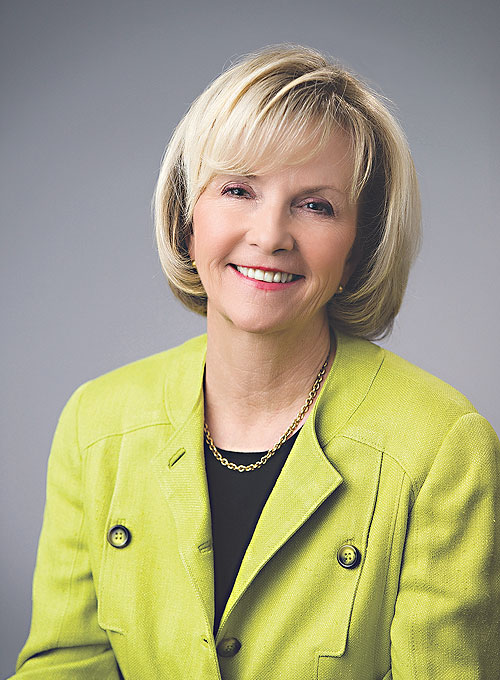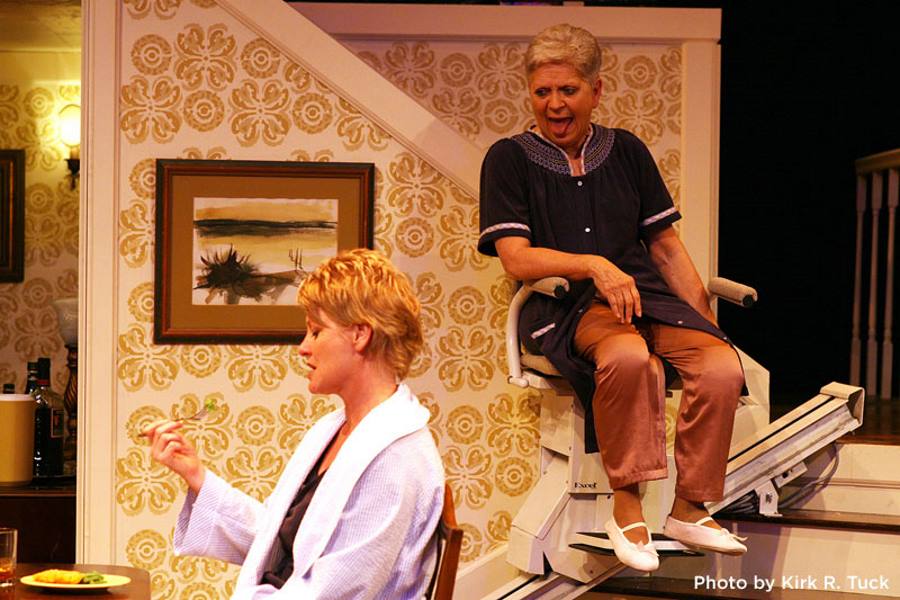It’s all there in the photo.
The family’s in black, and the funeral dinner has gone bonkers: Two women are covering their faces, two are being held gingerly for paltry comfort by men. Another woman stands upstage, solitary and indignant, appalled at whatever has just been said.
And you probably know how it goes from there in August: Osage County, the Pulitzer-winning, O’Neill-via-Oklahoma Tracy Letts epic that premiered at Chicago’s Steppenwolf Theatre Company in 2007 (then moved to Broadway for a Tony-winning run) and has gone on to a score of productions since (with a starry film version due out just in time for Oscar consideration). This is a play in which something atrocious is always tumbling out of somebody’s mouth.
But whose August is this? How did the creators of the production shown on the previous page manage to finesse the play’s well-known three-story set with only two floors’ worth of height? How many of those dishes are going to get smashed each night? Who whipped up the family dinner? How much does a plausible August cost, anyway?
“I have seen stripped-down, low-budget productions in nontraditional spaces that were perhaps more powerful than the ones able to employ a lot of technical wizardry,” says Dave Steakley, artistic director of Austin’s ZACH Theatre, which produced the August in question. (He’s talking about Angels in America, but you get the point.) “It is about making the play resonate for your space, with your audience, to the very best of your abilities.”
ZACH was a $3-million troupe as of spring 2011, when Steakley directed August on the flagship company’s 230-seat thrust-style Kleberg Stage. Last fall, ZACH opened a new mainstage—the 420-seat Topfer Theatre—thanks to a $23-million campaign begun in 2006. This season ZACH’s budget will more than double, to $7 million.

“We’re operating in a different world now,” says Elisbeth Challener, ZACH’s managing director. She illustrates this by comparing August in the Kleberg to the comparably sized (if not similarly spirited) production of Mary Chase’s 1944 comedy Harvey in the Topfer last spring:
- The August budget: $169,000, with $21,000 for production and $17,000 for the set (designed by Michael Raiford, with lighting design by Jason Amato).
- The Harvey budget: $220,000, with $50,000 for production and $27,000 for the set.
Ticket prices changed, too—dynamically so. (ZACH, like so many cultural institutions, uses demand-based pricing.) The average ticket price for August was $34, with a top of $59. For Harvey, $49.57 was the average, while the top hit $80. Apparently the economic downturn didn’t drag ZACH down too badly in 2008 or 2011. Challener says Austin was buffered from some harsh effects; the real-estate calamity was not as dramatic as in other parts of the country, and the Austin area is less than flush with corporate headquarters. These days, a whopping 70 percent of the 80-year-old institution’s income is earned, meaning that it comes from the sale of tickets, concessions or in-house products.
Still, ZACH was not totally sheltered from the economy’s rough weather. Finance director Linda Wilson reports that one of the 2010–11 shows had to be entirely rethought due to budget concerns, and a musical premiere was scratched when enhancement money fell through.
“It was a challenging year,” Wilson concedes. But she adds that the August: Osage County budget “was not changed dramatically from the first draft to the final approved budget.” Steakley, Challener, Wilson and director of production Paul Flint recall putting it together in the cozy but workable confines of the Kleberg (where the troupe had produced Hairspray that same season). At American Theatre’s invitation, they spelled out just how they spent the money.
THE SET

Steakley: “This is a play in which a family carefully guards its secrets. That becomes even more challenging when the space is confined. It raised the stakes of keeping information out of earshot of the play’s pill-addicted, acid-tongued matriarch Violet.”
Flint: “The hard scenery was about $17,000. That was a combination of $9,000 for materials and $8,000 for labor. This was on the higher end of our average for the Kleberg Stage, but still average. Furniture and other properties were an additional $3,000.”
Steakley: “When we do a two-level set [the max in the Kleberg], a consideration is the height of the actors, to make proportions work. The actors playing the characters who go to the attic—Violet, her caretaker Johnna and the teenager Jean—are all petite, so that helped us gain a few inches of height downstairs.”
Flint: “The third floor is unsupported for much of its span. The scenery department solved this design challenge by constructing one large stress skin platform that was set in place with chain motors. The addition of 3/8-inch plywood on the bottom greatly increased the strength and reduced the flex of the platform, and allows for the long unsupported span. The total weight of this platform was approximately 600 pounds, so this necessitated the use of two chain motors to lift it into place.
“We also wanted the floor to look like a real hardwood floor, and this can be difficult in such an intimate space. The floor had to be very durable to withstand the throwing of the chair and breaking of the plates. This resulted in a higher flooring cost than normal, because we used half-inch birch plywood and an epoxy finish—$1,500 in materials for the plywood, stain and epoxy finish and $500 in labor.”
Steakley: “Lana Dieterich, the outstanding veteran Austin actress who played Violet, had polio as a child and walks with a cane. A consideration when casting Lana in a play is that you have to make sure she doesn’t have to navigate any stairs in her blocking, as even a single step is a great deal of effort.”

Flint: “We constructed a private dressing room ($400 materials and labor) backstage at the second level so she could do her costume changes, etc., without going down the steps to the dressing rooms.”
Steakley: “When it was clear Lana was the best choice for the role of Violet, immediately I began to think about how could we possibly make this work, and the notion of an onstage chair-lift came to mind.”
Flint: “We were able to work with Home Elevator of Texas to rent this device at a very low price. We gave them a deposit of $1,500, but they refunded the majority once they received the unit back in good condition. We only paid for the piece of track ($500) that was custom cut for our purposes.”
Steakley: “We found ourselves making choices about when to create tension with just the hum of the machine when Violet was lowering or raising herself, and when to simply talk over the action of the chair. It underscored this as a place dominated by the matriarch.”
THE FURNITURE
Steakley: “We chose the 1970s as the point in which the house was basically getting locked in, style-wise. The vintage sofa ($150) that opens up into a bed was a great craigslist find by our props designer Blake Reeves. When the couple Bill and Barbara have to make the foldout sofa into a bed and are having their argument about Bill’s affair, they were all the way downstage. The audience was literally in the bedroom with them.”
The academic home office belonging to the family patriarch, Beverly (who vanishes after the opening scene), is positioned on a landing between the ground floor and the third-floor room occupied by Johnna, the Native American woman who is Violet’s live-in caretaker.
Steakley: “When the three sisters are reunited and are alone together drinking and talking in Beverly’s office, the space was very tight, and the small inflatable mattress ($15 at Walmart) was already present. I loved how this forced a physical intimacy between these sisters. It also allowed the eldest daughter, Barbara, to be in the power seat, which was Beverly’s desk chair ($80 from Austin’sAntiques Marketplace). But she cedes the chair to the mother when Violet enters this tight space, and is forced to sit on the floor.”
Flint:“The dining table came from Antiques Marketplace for $150. The dining chairs came fromAustin Furniture Consignment for $100 (total), minus two from stock.”
THE LIGHTING
- Two sconces: Heavenly Lighting, $90;
- Green desk lamp: Hog Wild Vintage, $35
- Floor lamp: Goodwill, $7
- Second table lamp: stock
Flint: “Nothing unusual.”
THE PROPS
Steakley: “Our crew had to cook a dinner for each performance, and everything had to be edible, given the proximity of the audience. Some of the cast may never be able to look at another green bean casserole again! Also, in the first act, apple pie is consumed by Bill, Barbara and Violet.”
Flint: “Cost of real food was about $800 for the run, with about $100 more for artificial food. The pies were store-bought and baked weekly in ZACH’s kitchen. The aroma was quite nice. The main cost for dishes came from our breakable plates that we purchased from Armadillo Clay. We broke a couple of plates a night. This cost $500 for the run of the show.
“Many of the books [in Beverly’s office] came from stock, but we purchased a few poetry books fromHalf Priced Books for $12. We also bought the T.S. Eliot book mentioned in the script from Amazon for $10, and a few books from Goodwill for $5.”
OTHER DINING ITEMS
- Non-breakable plates: Overstock.com, $22
- Flatware and bowls: Walmart, $44
- Wine and highball glasses: World Market, Spec’s, $33
- Additional glassware: Ikea, $40
- Relish dish: Out of the Past Collectibles, $8
- Coffee cups, serving plates: stock
THE COSTUMES
Costumes ($4,000 for materials, $2,500 for labor), designed by Susan Branch Towne, were mostly off-the-rack purchases.
Steakley: “For Susan, this was about thinking of what each character would have in his or her wardrobe for these occasions, and in the case of Barbara, Bill and Jean, what could be purchased off the rack at a store in Oklahoma or borrowed from another relative, since they did not know they would be attending a funeral when they hurriedly make their trek to Oklahoma from Colorado. Little Charles was an exception, in a navy jacket and khaki pants, missing the funeral and arriving late to dinner, a bit rumpled and not on the same color page as everyone else.”
Flint: “The cost was around $1,200 to costume the cast for this scene [in the opening photo].”
Steakley: “Corley Pillsbury, the young actress who played Jean, came to the audition with purple hair. I really loved it for the character. It created a wonderful moment of judgment when Aunt Mattie Fae first sees her. And when Violet first sees her, it created a huge laugh every night. It helped make Jean an alien to this home, clearly out of her element. “Mattie Fae is locked into a hairstyle she likes from a couple of decades ago. So Janelle Buchanan was wigged (total makeup/wig/beard budget: $500) for this role.”

THE ACTORS
Steakley: “ZACH was on an SPT 4 contract. [Note: At present, the troupe is on an SPT 5 contract.] Of the 13 actors, seven were on AEA contracts (then at a $293/week minimum, with pension and health benefits for some), which is a large number for us.”
Some actors made more than the AEA minimum, finance director Wilson notes. For the 11-week rehearsal and performance period, the pay for non-Equity actors ranged from $75 to $200 per week.
THE REVIEWS
For the record, ZACH’s August: Osage County was a hit, critically and financially. Lauren Lane, who played Violet’s professor daughter Barbara, earned lead acting kudos at the Austin Critics Table Awards, and Austin Chronicle critic Avimaan Syam enthused, “Its setting may be contained in three weeks and one Oklahoma house, but Letts’s play is truly epic…it attempts to fill the whole canvas, so to speak.” Examining exactly how much that canvas cost is a lesson in the economics of artistry…and perhaps vice versa.
Critic and arts journalist Nelson Pressley is based in Washington, D.C.


